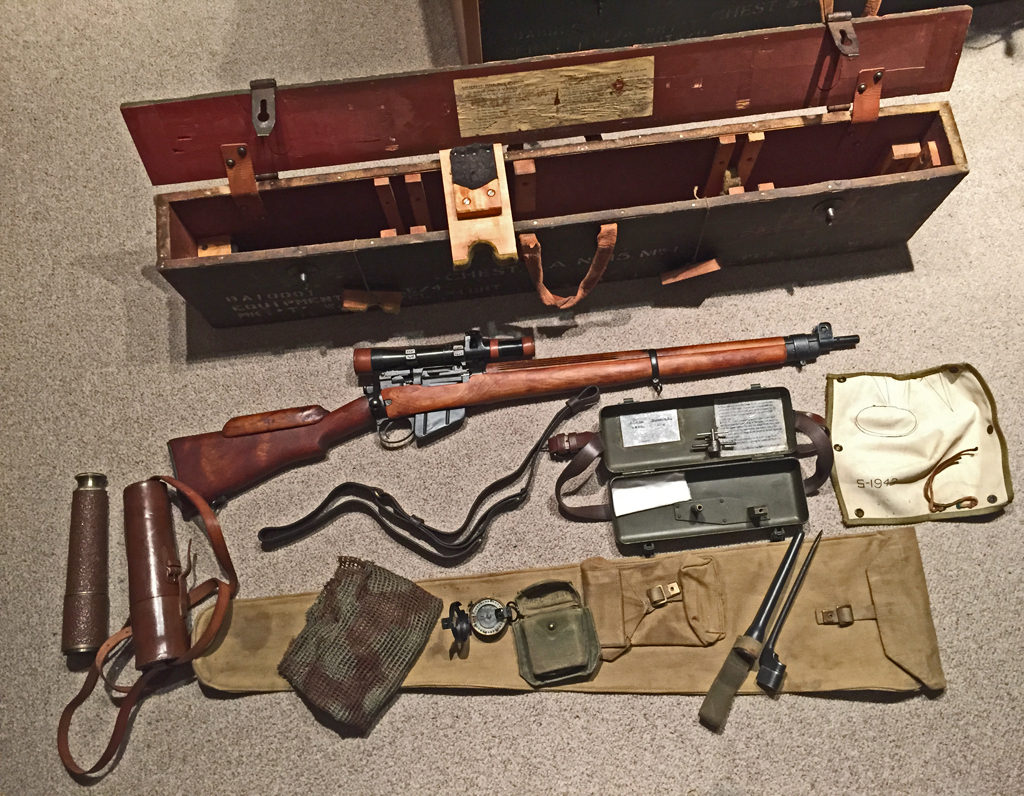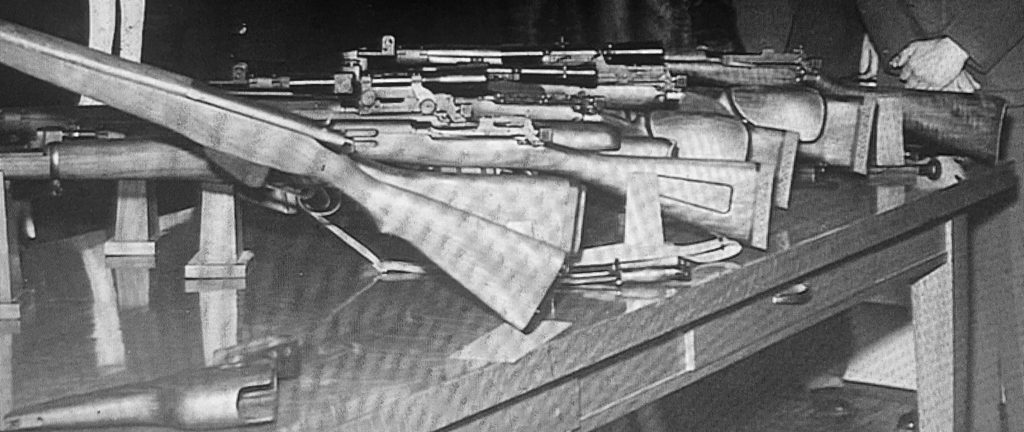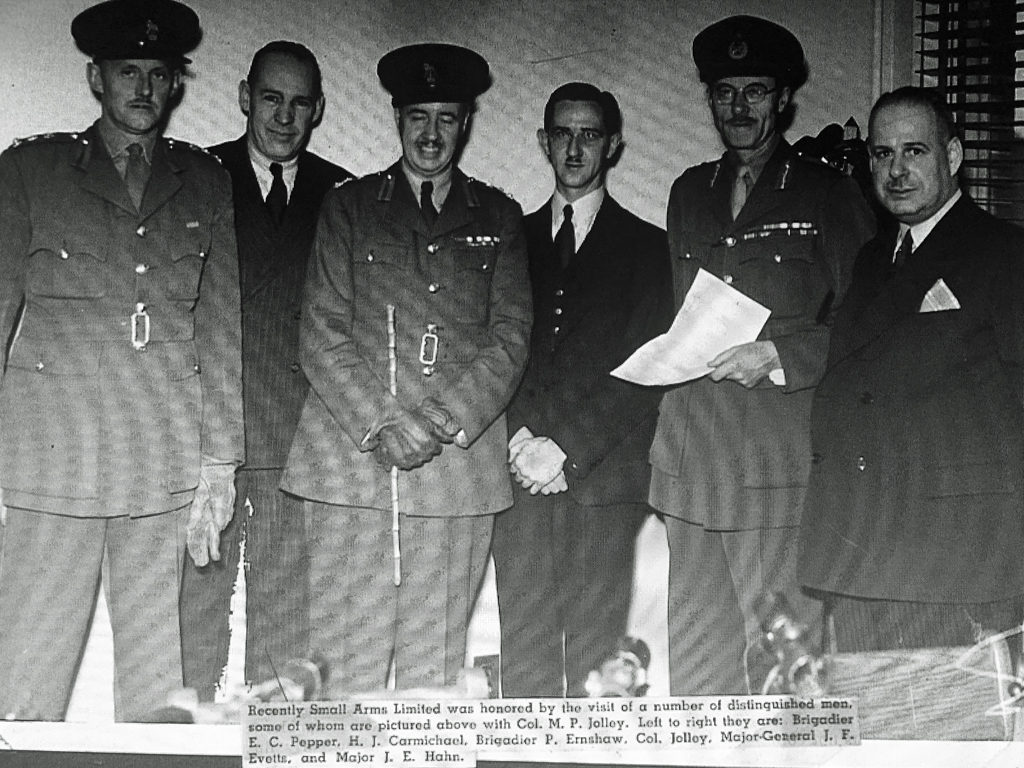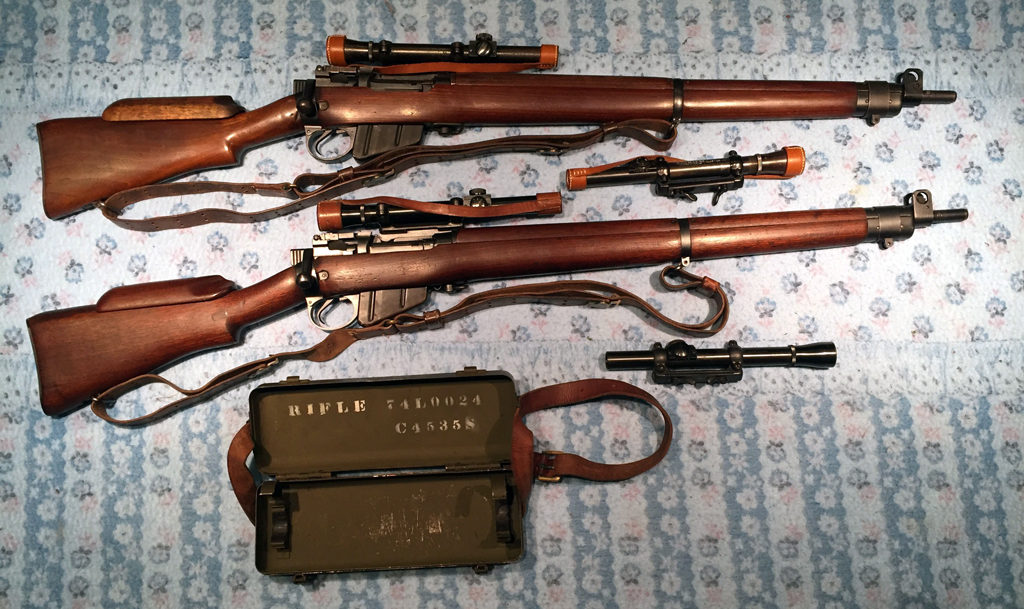
The Lee-Enfield No. 4 Mk. I (T) and No. 4 MK. I* (T) were the standard WWII sniper rifles for the British and for the British Commonwealth, except for Australia.
Prior to the creation of the No. 4 (T) conversions, a variety of WWI sniper rifles were in use by the British Commonwealth. These included:
- Ross MK. III sniper rifle with Model of 1913 Warner & Swasey Musket Sight (sniper scope) or Winchester A5 scope for Canada
- Pattern 1914 Mk. I W (F) renamed in 1926 No. 3 MK. I (F)] with “Fine” iron sight
- Pattern 1914 Mk. I* W (F) renamed in 1926 No. 3 MK. I* (F) with “Fine” iron sight
- Pattern 1914 Mk. I* W (T) renamed in 1926 No. 3 Mk. I* (T) with Model 1918 scope
- No. 3 Mk. I* (T) A with Aldis scope. 421 were converted by Alex. Martin in Glasgow.
My first YouTube video:
1945 Long Branch Sniper Rifle No 4 MkI* (T) 90L8xxx series – YouTube
HOW MANY No. 4 (T) RIFLES WERE MADE?
Not everyone agrees on the totals, but that is due to lack of complete archival records. The figures below do not include prototypes, pilot models and experimental sniper rifles, of which very few were made. For more information on these sniper rifles, including details of the number that were converted, please see these books:
- AN ARMOURER’S PERSPECTIVE by Peter Laidler and Ian Skennerton pp. 23 – 25
- WITHOUT WARNING by the late Clive Law. pp. 36 – 41
- THE LEE-ENFIELD by Ian Skennerton p. 229
- THE BRITISH SNIPER A Century of Evolution by Steve Houghton (2019)
1,403 Converted by Royal Small Arms Factory at Enfield in 1941-1942. Most were former Trials No. 4 Mk. I rifles from 1931 & 1933, but at least one was a Stevens-Savage.
21,617 Converted by Holland and Holland 1942-1946. Most of these were rifles made by BSA and marked “B”, or “M47” of “M47C” above the year on the body socket.
100 Parts kits sent to BSA. Their fate is not known, but we assume that they were assembled as .22 Long Rifle calibre training rifles. WARNING: At least one seller claims in September 2024 in the USA that their standard “common” BSA No. 4 Mk. I (T) in .303″ is one of only 100, when it is actually one of about 21,617, and by far the most common version.
1,588 Converted by Small Arms Limited and later Canadian Arsenals Limited at Long Branch 1942-1946.
TOTAL (as far as I can tell) 24,708
L42A1 – Of those No. 4 (T) about 1,100 to 1,200 were converted again, this time to L42A1 sniper rifles in 1970 – 1992.
No. 4 MK. I (T. LESS TELESCOPE)
3,440 remained unfinished at Holland & Holland on the date the contract with Holland and Holland ended in 1946 (ref. Laidler). These were designated “No. 4 MK. I (T. LESS TELESCOPE)” as they never had scopes mated to the rifles, and this designation was stencilled on the front of their No. 15 Mk. I wooden chests. As best we can tell from surviving examples, these rifles had the “S“, “TR“, “S51” marks and cheek rests, but neither the “T” nor scope serial number on the wrist of the butt. Most of these were Stevens-Savage made, from 1941-1942, but some were made at BSA-Shirley in 1944-1945.
An earlier batch of unfinished No. 4 Mk. I (T. LESS TELESCOPE) were Stevens-Savage rifles left unfinished, presumably because Holland & Holland reported that it was more efficient for them to convert rifles from one maker only, i.e. BSA, as jigs etc. could be set up and used consistently.
The later unfinished conversions are I believe, those that were incomplete at the date and time that the contract finished when it was “Down tools lads. The Government is not paying us another penny.”
Collectors need to be especially careful when purchasing No. 4 (T) rifles.
Most No. 4 (T) sets sold in North America appear to have been sold with mismatched scopes by surplus dealers. Although a mismatched scope and bracket look correct, if they are not mated to the rifle in military service, then the scope is not collimated to the rifle barrel. as the unfinished No. 4 MK. I (T. LESS TELESCOPE) rifles, being already 80% converted, are the easiest to “finish off” though they would not be properly collimated (i.e. scope not perfectly aligned to the barrel). Collectors also need to be very careful of any No. 4 (T) sniper rifles converted before 1944 as the markings took time to become standardized and it can be very difficult to detect a fake.
WARNING! Many so-called No. 4 Mk. I (T) “sniper” rifles are actually No. 4 Mk. I (T. LESS TELESCOPE) rifles, i.e. unfinished conversions. They usually have an orphaned scope set, though now many have replica or fake (i.e. with fake wartime year and s/n) scope sets, as are sold as real “sniper rifles”. They look the same and most of the conversion work was actually done by Holland & Holland, but they were never completed as sniper rifles.
For American collectors this is similar to the “M1C sniper rifles” that were stamped “SA 52” on the flat area behind the rear sight. These rifles were drilled and tapped by Griffin & Howe, but never had scope sets fitted. During the Korean War, these rifles had the holes plugged and the rifles were issued as standard M1 rifles. Some people have “restored” them as M1C rifles by adding the correct models of scope sets, but they never were issue sniper rifles.
REJECTS
681 – Holland and Holland rejected 681 rifles and these would have been replaced by other rifles. However, they would likely have the “S” and “TR” markings, possibly cancelled upon rejection. As well, R.S.A.F. Enfield rejected one Holland and Holland completed rifle.
R.S.A.F. ENFIELD CONVERSIONS
In 1941 and early 1942, 1,403 Lee-Enfield No. 4 MK. I rifles were converted at Royal Small Arms Factory Enfield. Most, but not all, of these were 1931 and 1933 Trials rifles. At least one of these early conversions by Enfield was a Stevens-Savage No. 4 Mk. I made in the USA and a few may have been made by Maltby and BSA. Rifles converted by them are marked with a tiny Enfield examiner’s stamp on the top of the front scope pad and no “S51” stamp on the underside of the butt stock.
HOLLAND AND HOLLAND CONVERSIONS
Late in 1942 a contract was issued to Holland and Holland, the famous gunmakers in London, England, to convert rifles into sniper equipment. Rifles converted by them were marked “S51″ in 1/4” high letters on the underside of the butt.
This web page will eventually go into detail on these rifles. I wish to thank the many collectors and museums who have granted me access to photograph their items.
SMALL ARMS LIMITED (S.A.L.) at LONG BRANCH CONVERSIONS
The Canadian sniper rifles were produced at Small Arms Limited at Long Branch (two words) Toronto, Ontario, Canada.
On Flikr there were are some albums of official photos posted by Gary Blakeley, but they do not appear to still be there as the links were broken. Two of the photos in “Small Arms Ltd., Company Photo Album” show sniper rifles. The second and fourth albums are of Small Arms Limited at Long Branch where the Lee-Enfield No. 4 rifles and the Sten Gun MK. II were made. The wooden shoulder stock/holster for the Inglis pistol was also made at SAL. The first and third albums are of John Inglis Company which made Browning Machine Guns, Bren Guns and No. 1 and No. 2 pistols (versions of the Browning High Power Model 35). NFB is “National Film Board” of Canada which did a lot of documentary film work. Low resolution copies of those two images are shown here.

- On page 1, the 12th photo entitled “Princess Alice – 5” Princess Alice is in the centre wearing the fur coat, was a granddaughter of Queen Victoria and was married to the Earl of Athlone, Governor General of Canada during WWII. In front of the people is a display of firearms made at Small Arms Limited, Long Branch. Nearest the camera to the people:

Sniper rifles are shown below in bold font.
- Chinese contract wooden holster for the Inglis No. 1 MK. I pistol.
- Long Branch Training Rifle (non-firing). similar in concept to the British Swift Training Rifle apparently.
- No. 5 Mk. I “Jungle Carbine” prototype. This model was not manufactured in Canada other than prototype(s).
- No. 4 Lightweight . Notice lightening cuts in fore end and butt.
- No. 4 MK. I* (T) with a British style mount for No. 32 and No. 67 scopes. It appears to be a No. 32 scope. Butt stock has British style cheek rest on top and the butt plate is standard metal one.
- No. 4 MK. I* (T) It looks like a Trade Pattern with Canadian variation of U.S. Griffin & Howe mount and Lyman Alaskan scope but with the Canadian Monte Carlo type butt and rubber butt-pad.
- No. 4 MK. I* (T) with what may be a No. 67 MK. I scope and Canadian Monte Carlo cheekiest and rubber butt pad.
- No. 4 MK. I* with MK. II simple “L” back sight. This appears to be a standard mid-war production specimen.

- On page 2, the 11th photo entitled “Army Officers -2” shows 6 men. In the foreground, out of focus are thee sniper scopes mounted on rifles. Unfortunately they are out of focus. This photo was probably taken in the same room as the first photo with Princess Alice.


Private Peter Braidwood parachuted into Normandy carrying a No. 4 MK. I (T) with 1 Canadian Parachute battalion in the 6th Airborne Division. He also carried one in the Battle of the Bulge when 6 AB Div was sent over by sea and land, due to the bad weather, to reinforce the Americans. Peter was issued another No. 4 MK. I (T) but as it had shrapnel in the furniture, he managed to “accidentally” drop it during a practice parachute jump. He was issued a fresh No. 4 MK. I (T) which he carried on the Operation Varsity parachute jump into Germany in March 1945 and on the advance to Wismar to cut the Soviets off from illegally occupying Denmark. The scope shown here, No. 32 MK. I serial number 7466, was issued to 1 Canadian Parachute Battalion, so it is possibly one that Peter carried in battle. The scope only was brought back as a souvenir by Private George Siggs of 1 Can Para Bn. Sadly Peter Braidwood died less than a week after I took this photo. The scope 7466 is shown here mounted on an early British sniper rifle, a 1943 BSA Shirley serial number AT4872 made No. 4 MK. I (T) which is now in a private collection in Quebec fitted with a different scope.

MISMATCHED SETS
The No. 4 (T) rifles each had a scope mated to them at the time of conversion. The rifle was marked with the scope serial number on the wrist, the flat spot on top of the wooden butt stock, just underneath and aft of the cocking piece. If a scope had to be changed in service due to damage, loss or upgrading to a newer model, the old scope number was cancelled and the new number was marked. The process was very specialized and involved PERFECTLY aligning (collimating) the scope and the rifle barrel.
Sadly, when most of the No. 4 (T) sniper sets were sold in North America, most of the surplus dealers either did not realize or care, to match up the scopes to the rifles. As a result, most sets are mismatched. A matched set is much more valuable and is a better shooter,.
How to solve the problem?
There are two options at the moment.
Contact me. I have a research database listing roughly 2,000 serial numbers at this time. This includes matching sets as well as serial numbered components such as scopes, brackets, rifles and scope cases. So far I have managed to “match-up” over two dozen sets. Sadly however, the owners cannot always agree and reach a satisfactory conclusion, but there have been successes.
-
- A rifle in Scotland, bought out of the USA. I found the scope in the USA and he worked a trade and his set is now matching.
- I purchased a No. 4 Mk. I (T) out of Pennsylvania and imported it to Canada. Then Brian Dick of www.bdlltd.com in North Carolina found the matching scope set in Nebraska. I ended up sending the rifle to Nebraska and it is now reunited.
- I alerted a collector in California about a rifle matching his scope set that was for sale in the USA. I helped him to acquire it. Happily me later traded a Canadian No. 15 Mk. I chest for a British one. In Australia I found the Long Branch rifle that matched a Lyman sniperscope that I had though we were unable to reach a trade deal.
- More recently I found the scope set originally fitted to a 1930s Trials rifle, converted to No. 4 Mk. I (T) at R.S.A.F. Enfield in 1941-1942, and informed the owner of the matching rifle. He bought it and the set is now reunited.
AND
Forum ~Angel’~s ‘Match Making’ Serivice on MILSURPS.COM at https://www.milsurps.com/forumdisplay.php?f=48
For people wanting to find matching parts to complete their rifle set. This could be bolt,

In the latter part of the 1950s, Canada, Britain and others adopted the Belgian designed FN FAL type rifles in 7.62×51 mm. The calibre was insisted upon by the Americans, who soon “broke ranks” and adopted the 5.56mm while in the Vietnam War.
The British were planning on having an FN L1A1 rifle with sniper scope as a sniper rifle. They conducted experiments to convert the .303″ rifles to 7.62×51 mm NATO, primarily for potential foreign sales. In 1964, six .303″ No. 4 Mk. I (T) rifles were test fired and then converted to 7.62x51mm. These have been incorrectly labelled as the “L8(T)” but research in England has showbn that they were never officially renamed and that they were not specially marked. These six rifles were:
SERIAL NUMBER & PRESENT OWNERS
1 – Q31560 Royal Armouries Museum, Leeds, UK https://royalarmouries.org/collection/object/object-49765
2 – T32908 Royal Armouries Museum, Leeds https://royalarmouries.org/collection/object/object-270739
3 – U32340 Colin MacGregor Stevens’ Collection, Canada. There are still some mysteries about this rifle. It was later falsely marked as EXP13 and had the charger bridge removed, and a .303 barrel fitted, but it was a genuine No. 4 Mk. I (T) and serial number is marked as U32340. The scope set is a mismatched original set.
4 – V37975 Private collection ex-Robert Etherington Collection in 2011. Subject of your YouTube video on Forgotten Weapons. Now owned by a private collector in the USA. It was imported to the USA by Brian Dick of BDL Ltd. “L8(T)” https://www.youtube.com/watch?v=F5axeVX84gs
5 – X32072 This one is in the National Army Museum in Chelsea, London, England.
6 – X32437 Royal Armouries Museum, Leeds https://royalarmouries.org/collection/object/object-270738
The FN did not prove to be satisfactory as a sniper rifle, so some more experiments were carried out and after looking at the success civilian target shooters were having with heavy free=floating barrels, the British came up with the L42A1 sniper rifle. This was a connversion of about 1,200 No. 4 (T) sniper rifles to 7.62×51 mm NATO. Canada chose to go with the Parker-Hale C3 Sniper Rifle which was a P-H 1200TX fitted with an Austrian Kahles ZF 69 scope that Canada called the C2.
LINKS TO OTHER WEB PAGES:
-
Sniper Rifles & Snipers
-
Ross Sniper Rifles
-
Pattern 1914 (later renamed No. 3) Sniper Rifles
-
Lee-Enfield No. 4 Mk. I (T) Sniper Rifle (this page)
-
No. 4 (T) Research Database
-
No. 4 Mk. I (T) Sniper Equipment Markings
-
Long Branch Scout Sniper’s Rifle 1943-1944
-
R.E.L. C No. 67 Mk. I sniper scope
-
R.E.L. Scope Case C No. 8 Mk. 2
-
Sniper Scope Tools
-
Sniping Observation Telescopes
-
“Shoot To Live” book 1945 Canadian Army *
-
FN C1A1 Sniper Rifle
-
C3 Sniper Rifle
-
C3A1 Sniper Rifle
-
MacMillan C15 (TAC-50)
-
U.S. M1903A4 Sniper Rifle
-
OTHER WEB SITES TO LOOK FOR
Forgotten Weapons video on YouTube “No4 MkI (T)”
A 1944 BSA Shirley rifle R35125, scope No. 32 Mk. 3 # 24571 at RIA Rock Island Auctions 2018
MILSURPS.COM https://www.milsurps.com/forumdisplay.php?f=72
MILSURPS.COM From No4 Mk I (T) to L42 AI – Part 1 (by Graeme ‘broadarrow303’ Barber)
MILSURPS.COM From No 4 Mk I (T) to L42A1 – Part 2 by Graeme ‘broadarrow303’ Barber)
MILSURPS.COM 1944 Enfield No.4 Mk1*(T) Long Branch TP (Trade Pattern) Sniper Rifle
MILSURPS.COM 1943-44 Enfield No.4 Mk1* Experimental Long Branch ‘Scout’ Sniper Rifle
“I Have This Old Gun: British Lee-Enfield No. 4 (T) Sniper Rifle”
NRA American Rifleman video on YouTube about a No. 4 Mk. I (T) Rifle serial number D37776 ?(last digit uncertain) and scope 18218, matching set. There are minor errors e.g. showing a cased L42A1 with scope case numbered 26138 whilst talking about the No. 15 Mk. I chest. They do speak about the later 7.62mm L42A1 version, made from No. 4 (T) rifles.
YouTube video ” Enfield Rifle No4Mk1T 1945 M47C CFC 2018“
“Riflechair” fires his BSA No. 4 Mk. I (T) without scope and bracket.
M1907 Sling – This was an American sling that was the normal issue with the No. 4 (T) sniper rifles.
- US M1907 Sling (search those words in that order. Direct link not shown as their web site is not secure)
- M1907 SLING INSTALLATION by the Civilian Marksmanship Program (CMP) in the USA (Direct link not shown as their web site is not secure)
- The Use of the M1907 Sling by Walt Kuleck – Fulton Armory From FM 23-5, October 1951 (Direct link not shown as their web site is not secure)